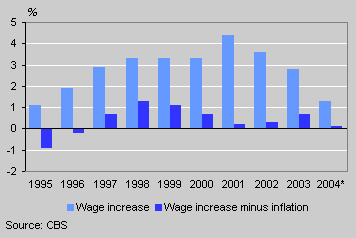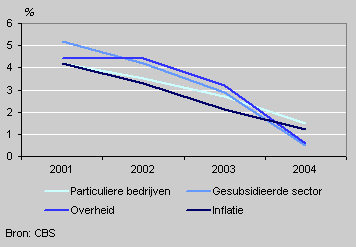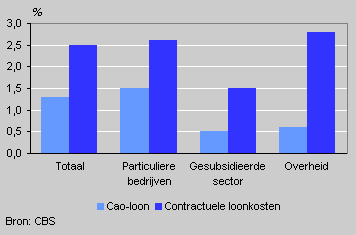Collectively agreed wages keep up with inflation rate in 2004

CCollectively agreed wages rose by 1.3 percent in 2004, considerably less than in 2003, when the increase was 2.8 percent. The downward trend began in 2002. The annual increase in collectively agreed wages now virtually equals the inflation rate. In the last months of 2004 the increase in collectively agreed wages slipped under the inflation rate.
Collectively agreed hourly wages (including special bonuses)

Since 1997 the collectively agreed wage rate have risen stronger than the inflation rate. Corrected for inflation, the average collectively agreed wage of employees rose by about 0.6 percent annually in the period 1997-2004.
Employees’ contributions to social costs and income tax are part of collectively negotiated wages. In the years in which they change, the purchasing power will deviate from the collectively agreed wages corrected for inflation.
Most substantial wage increase in the private sector
In the private sector collectively agreed wages rose by 1.5 percent, the most substantial rise in 2004. The increase in the subsidised sector by 0.5 percent and in the public sector 0.6 percent was about half the inflation rate. In the period 2001-2003 collectively agreed wages in the private sector lagged behind the public and subsidised sectors.
Collectively agreed wages and inflation

Wage costs rise faster than collectively agreed wages
In 2004 the increase in contractual wage costs by 2.5 percent was almost twice the increase in collectively agreed wages. The difference between the increase in collectively agreed wages and contractual wage costs grew to reach 1.2 percent. In 2002 and 2003 the difference was only 0.6 percent. The increased difference in 2004 was caused by higher employer-paid contributions to pension schemes, unemployment and basic premium for the Disablement insurance act.
Collectively agreed wages and contractual wage costs, 2004

Sharpest wage costs increase in the public sector
The public sector as one of the three sectors where wages are collectively negotiated, had the largest increase in wage costs by 2.8 percent, over four times as fast as collectively agreed wages. The difference between the increase in collectively agreed wages and wage costs is by far highest in the public sector (2.2 percent). Higher contributions made by employers to pension schemes largely account for this development.
Nathalie Peltzer